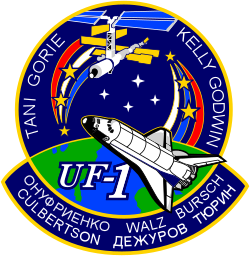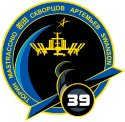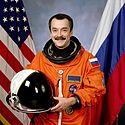Michail Ťurin
| Michail Vladislavovič Ťurin | |
|---|---|
 | |
| Kosmonaut RKK Eněrgija, od 2011 CPK | |
| Státní příslušnost | Rusko |
| Datum narození | 2. března 1960 (64 let) |
| Místo narození | Kolomna, Moskevská oblast, RSFSR |
| Předchozí zaměstnání | Inženýr |
| Čas ve vesmíru | 532 dní, 2 hodiny a 52 minut |
| Kosmonaut od | 1. dubna 1994 |
| Mise | Expedice 3 (STS-105/ISS)/STS-108 Expedice 14 (Sojuz TMA-9/ISS) Expedice 38/39 (Sojuz TMA-11M/ISS) |
| Znaky misí | |
| Kosmonaut do | 18. ledna 2016 |
| Některá data mohou pocházet z datové položky. | |
Michail Vladislavovič Ťurin (rusky Михаил Владиславович Тюрин; * 2. března 1960 Kolomna) je od dubna 1994 ruský kosmonaut, člen oddílu kosmonautů RKK Eněrgija. V letech 2001 a 2006/2007 absolvoval dva půlroční kosmické lety na Mezinárodní vesmírnou stanici (ISS) o celkové délce 344 dní. Potřetí se na ISS vydal na půlroční misi v listopadu 2013 jako člen Expedice 38/39.
Život
Mládí
Michail Ťurin pochází z Kolomny v Moskevské oblasti, narodil se v dělnické rodině, je ruské národnosti.[1] Roku 1984 absolvoval Moskevský letecký institut, obor produkce letadel. Poté nastoupil v RKK Eněrgija, zde se zabýval problematikou řízení kosmických lodí Sojuz.[2]
Kosmonaut
Začátkem devadesátých let se přihlásil k kosmonautickému výcviku, prošel lékařskými prohlídkami a 16. června 1992 získal souhlas Hlavní lékařské komise k přípravě. Rozhodnutím Státní meziresortní komise byl 1. dubna 1994 vybrán do oddílu kosmonautů RKK Eněrgija, formálně zařazen v Eněrgiji na pozici kandidáta na kosmonauta byl 16. června 1994. Absolvoval dvouletou všeobecnou kosmickou přípravu v Středisku přípravy kosmonautů J. A. Gagarina a 25. dubna 1996 získal kvalifikaci zkušební kosmonaut.[2]
Od května 1996 byl zařazen mezi kosmonauty připravující se na lety na Mir. V červenci 1997 přešel do skupiny určené pro lety na ISS a byl určen palubním inženýrem záložní posádky Expedice 1 a hlavní posádky Expedice 3, společně s Jurijem Onufrijenkem (od října 1997 Vladimirem Děžurovem a Kennethem Bowersoxem, od září 1999 byl velitelem Expedice 3 Frank Culbertson).[2]
Do vesmíru odstartoval 10. srpna 2001 na palubě raketoplánu Discovery letu STS-105. Na stanici ISS vystřídal s Culbertsonem a Děžurovem Expedici 2 a setrval na ní následující čtyři měsíce. V průběhu letu uskutečnil tři výstupy do otevřeného vesmíru o celkové délce 13 hodin 35 minut. Členové Expedice 3 se vrátili na Zem 17. prosince 2001 v raketoplánu Endeavour (let STS-108).[3]
Od prosince 2003 do dubna 2005 se připravoval ve funkci velitele záložní posádky Expedice 11 s Donaldem Pettitem (od ledna 2004 nahrazeným Danielem Tani).[2] V srpnu 2005 nahradil nemocného Alexandra Lazutkina v záložní posádce Expedice 12 a hlavní posádce Expedice 14.[2]
Ke svému druhému letu vzlétl 18. září 2006 v Sojuzu TMA-9 (velitel lodi) s Michaelem Lopez-Alegriou (palubní inženýr) a vesmírnou turistkou Anuší Ansariovou. Členové Expedice 14 – velitel Lopez-Alegria a palubní inženýr Ťurin převzali stanici od Expedice 13, jejíž dva členové (Pavel Vinogradov a Jeffrey Williams) s Ansariovou po týdnu přistáli se Sojuzem TMA-8, přičemž zbývající člen Expedice 13 Thomas Reiter přešel do nové posádky. V prosinci 2006 raketoplán Discovery přivezl Sunitu Williamsovou, která nahradila Reitera. Během letu Ťurin dvakrát vystoupil do vesmíru, dohromady na 11 hodin 56 minut. V dubnu 2007 Lopez-Alegria s Ťurinem předali stanici následníkům z Expedice 15 a 21. dubna přistáli na Zemi.[4]
Začátkem roku 2011 byl zařazen do posádky Expedice 38/39 s plánovaným startem v listopadu 2013.[2]
V souvislosti s rozhodnutím Roskosmosu o shromáždění ruských kosmonautů v jednom oddílu odešel ze společnosti RKK Eněrgija a od 26. února 2011 je kosmonautem Střediska přípravy kosmonautů.[2]
K ISS odstartoval 7. listopadu 2013 ve funkci velitele lodi Sojuz TMA-11M, společně s Američanem Richardem Mastracchio a Japoncem Kóiči Wakatou, po šestihodinovém letu se Sojuz se spojil se stanicí. Na ISS pracoval jako palubní inženýr osmatřicáté a (od března 2014) devětatřicáté Expedice.[5] Dne 14. května 2014 se celá posádka vrátila v pořádku na Zem.[6]
V lednu 2016 přešel na místo zástupce velitele oddílu kosmonautů (pro přípravu kosmonautů), přičemž zároveň přestal být aktivním kosmonautem.[2] Roku 2019 Roskosmos informoval, že zůstal členem oddílu i jako neaktivní kosmonaut, a sice na pozici takzvaného kosmonauta-manažera.[7]
Michail Ťurin je ženatý, má dceru.[2]
Tituly, řády a vyznamenání
- Hrdina Ruské federace (12. dubna 2003),[2]
- Letec-kosmonaut Ruské federace (12. dubna 2003),[2]
- Řád Za zásluhy o vlast IV. třídy (23. října 2008),[2]
- Medaile Za zásluhy v osvojení vesmíru (12. dubna 2011),[2]
- Řád Za zásluhy o vlast III. třídy (26. srpna 2016).[2]
Odkazy
Reference
- ↑ OSOVIK, Kirill. Герои Страны [online]. [cit. 2009-04-20]. Kapitola Тюрин Михаил Владиславович. Dostupné online. (rusky)
- ↑ a b c d e f g h i j k l m n IVANOV, Ivan, a kol. Космическая энциклопедия ASTROnote [online]. Moskva: rev. 2019-11-10 [cit. 2020-01-29]. Kapitola Михаил Владиславович Тюрин.. Dostupné online. (rusky)
- ↑ HOLUB, Aleš. MEK. Malá encyklopedie kosmonautiky [online]. Rev. 2002-01-12 [cit. 2009-04-21]. Kapitola Expedice 3. [dále jen MEK]. Dostupné online.
- ↑ Holub. Rev. 2007-04-21 [cit. 2009-04-21]. Kapitola Expedice 14.
- ↑ RKK Eněrgija. Экспедиция МКС-38/39 [online]. Koroljov: RKK Eněrgija [cit. 2014-03-18]. Dostupné v archivu pořízeném dne 2013-11-09. (rusky)
- ↑ Holub. Rev. 2014-5-14 [cit. 2014-06-11]. Kapitola Sojuz TMA-11M.
- ↑ РЫЖКОВ, Евгений; МАРИНИН, Игорь. О космонавтах и астронавтах. Русский космос. Červen 2019, s. 18–25. Dostupné online. (rusky)
Externí odkazy
 Obrázky, zvuky či videa k tématu Michail Vladislavovič Ťurin na Wikimedia Commons
Obrázky, zvuky či videa k tématu Michail Vladislavovič Ťurin na Wikimedia Commons - BATURIN, Jurij. В космосе мы больше никому не нужны. Новая газета [online]. 2009-11-20 [cit. 2011-2-22]. Čís. 129. Dostupné v archivu pořízeném dne 2010-08-20. ISSN 1682-7384. – rozhovor s Michailem Ťurinem
Média použitá na této stránce
This is the mission patch of STS-108. Space Shuttle Endeavour is seen approaching the International Space Station. Two astronaut symbols represent the crew commanders of both ISS expeditions. The ascending one represents cosmonaut Yury Onufriyenko of Russia. (The ascending astronaut symbol shows a flag of Russia.) The descending astronaut symbol represents Frank Culbertson of the USA. This represents crew rotation, as three stars are depicted on the symbols. The space shuttle crew members are depicted along the border while the ISS crews are depicted along the chevron on the border of the patch.
- This is the insignia for the STS-108 mission, which marks a major milestone in the assembly of the International Space Station (ISS) as the first designated Utilization Flight, UF-1. The crew of Endeavour will bring the Expedition Four crew to ISS and return the Expedition Three crew to Earth. Endeavour will also launch with a Multi-Purpose Logistics Module (MPLM) that will be berthed to ISS and unloaded. The MPLM will be returned to Endeavour for the trip home and used again on a later flight. The crew patch depicts Endeavour and the ISS in the configuration at the time of arrival and docking. The Station is shown viewed along the direction of flight as will be seen by the Shuttle crew during their final approach and docking along the X-axis. The three ribbons and stars on the left side of the patch signify the returning Expedition Three crew. The red, white and blue order of the ribbons represents the American commander for that mission. The three ribbons and stars on the right depict the arriving Expedition Four crew. The white, blue, red order of the Expedition Four ribbon matches the color of the Russian flag and signifies that the commander of Expedition Four is a Russian cosmonaut. Each white star in the center of the patch represents the four Endeavour crew members. The names of the four astronauts who will crew Endeavour are shown along the top border of the patch. The three astronauts and three cosmonauts of the two expedition crews are shown on the chevron at the bottom of the patch.
ISS Expedition 38 Patch
As the International Space Station (ISS) has become a stepping stone to future space exploration, the Expedition 38 mission patch design paints a visual roadmap of exploration beyond low Earth orbit, most prominently represented by the design's flowing Expedition 38 mission numbers that wrap around Earth, the moon and Mars. Just as the sun is a guiding light in the galaxy, the ISS illuminates the bottom of the design as it is a shining beacon of the advancement of science, knowledge, and technology carried out aboard the Space Station. To visually capture the idea of the ISS being a foundation for infinite discovery, the space station's iconic solar arrays span upwards, providing the number 38 and its exploration roadmap a symbolic pedestal to rest on. Finally, the overall use of red, white, and blue in the design acknowledges the flags of the countries of origin for Expedition 38's crew -- the United States, Russia, and Japan.
ISS Expedition 39 Patch
Increment 39 of the International Space Station Program marks the 15th year of operation since the start of the space laboratory assembly. Today, the U.S., Russia, Japan, Canada and the European Space Agency are partnering in the operation of the largest ever orbital outpost managed by humankind. The names of the six crew members are depicted in their native languages. For Expedition 39, the Soyuz spacecraft serves as transport vehicle for the crew members to and from the station. During this expedition, the ISS will serve as a platform for scientific research, Earth and astronomical observation, education, as well as a stage for the development of new technologies used for the exploration beyond low Earth orbit. The star above the complex signifies human space exploration towards new frontiers. The crew members added these words: "The crew of Expedition 39 is proud to serve the international community in furthering our scientific knowledge and in expanding human presence in space."
The STS-105 crew patch symbolizes the exchange of the Expedition Two and Expedition Three crews aboard the International Space Station. The three gold stars near the ascending Orbiter represent the U.S. commanded Expedition Three crew as they journey into space, while the two gold stars near the descending Orbiter represent the Russian commanded Expedition Two crew and their return to Earth. The plumes of each Orbiter represent the flags of the United States and Russia and symbolize the close cooperation between the two countries. The Astronaut Office symbol, a star with three rays of light, depicts the unbroken link between Earth and the newest and brightest star on the horizon, the International Space Station (ISS). The ascending and descending Orbiters form a circle that represents both the crew rotation and the continuous presence in space aboard the ISS. The names of the four astronauts who will crew Discovery are shown along the border of the patch. The names of the Expedition Three and Expedition Two crews are shown on the chevron at the bottom of the patch. The NASA insignia design for Shuttle flights is reserved for use by the astronauts and for other official use as the NASA Administrator may authorize. Public availability has been approved only in the form of illustrations by the various news media. When and if there is any change in this policy, which we do not anticipate, it will be publicly announced.
This emblem embodies the past, present, and future of human space exploration. The Roman numeral XIV suspended above the Earth against the black background of space symbolizes the fourteenth expeditionary mission to the International Space Station (ISS), or Международная Космическая Станция. Elements of this symbol merge into a unified trajectory destined for the moon, Mars, and beyond, much as science and operations aboard the ISS today will pave the way for future missions to our celestial neighbors. The five stars honor the astronauts and cosmonauts of missions Apollo 1, Soyuz 1, Soyuz 11, Challenger, and Columbia, who gave their lives in the pursuit of knowledge and discovery.
Cosmonaut Mikhail Tyurin representing Russia's Federal Space Agency
ISS Expedition 3 Mission patch
It depicts the book of space history, turning from the chapter with the Russian space station Mir and the space shuttle to the next chapter, one that will be written on the blank pages of the future by space explorers working for the benefit of the entire world. Above the book is a layout of what the station will look like when completed, docked with the space shuttle. The Expedition Three crew members – astronaut Frank L. Culbertson, Jr., commander, and cosmonauts Vladimir N. Dezhurov and Mikhail Tyurin, flight engineers – had the following to say about the insignia for their scheduled mission aboard the International Space Station (ISS): “The book of space history turns from the chapter written onboard the Russian Mir Station and the U.S. Space Shuttle to the next new chapter, one that will be written on the blank pages of the future by space explorers working for the benefit of the entire world. The space walker signifies the human element of this endeavor. The star representing the members of the third expedition, and the entire multi-national Space Station building team, streaks into the dawning era of cooperative space exploration, represented by the image of the International Space Station as it nears completion.”






